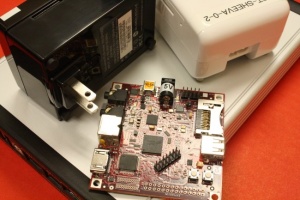From Fedora Project Wiki
| Line 53: | Line 53: | ||
* F17 (Work in progress) | * F17 (Work in progress) | ||
** [[Architectures/ARM/Fedora17_rawhide|Issues with Fedora 17 Rawhide mass rebuild]] | ** [[Architectures/ARM/Fedora17_rawhide|Issues with Fedora 17 Rawhide mass rebuild]] | ||
** [[Architectures/ARM/Quality_Assurance/2012-06-15-VFAD-Fedora_17_Test_Day | Fedora 17 RC1 VFAD Results]] | |||
** [[Architectures/ARM/Quality_Assurance/2012-06-18-VFAD-Fedora_17_Test_Day | Fedora 17 RC2 VFAD Results]] | |||
* Fedora 15: Complete, but notes below for reference. | * Fedora 15: Complete, but notes below for reference. | ||
** [[Architectures/ARM/Fedora15 HardFP Bootstrap|Fedora 15 Hardware Floating Point Bootstrap]] | ** [[Architectures/ARM/Fedora15 HardFP Bootstrap|Fedora 15 Hardware Floating Point Bootstrap]] | ||
Revision as of 14:51, 18 June 2012

Introduction
ARM chips are the most widely-produced processor family in the world; they have historically been used in cell phones and embedded applications, and are increasingly used in tablet devices and low-power-consumption servers.
The Fedora-ARM project is an initiative to bring Fedora to this processor family.
Communication
- Mailing list: arm@lists.fedoraproject.org (archives)
- IRC: #fedora-arm on Freenode
Meetings
- IRC: #fedora-meeting-1 each Wednesday at 20:00 UTC (4PM EDT) on Freenode (archives)
Planning
Resources
Detailed information on Fedora-ARM:
- Running Fedora-ARM on your ARM device, or through emulation on your PC
- Fedora ARM Koji (package builder) instance
- Information for Fedora package maintainers on getting your packages to work on ARM
- Information for Fedora-ARM team members (and prospective team members!) plus developers
- How to get an armv5tel cross toolchain installed on your x86 Fedora host
- How to build a kernel and cross-compile for ARM
- Building and Installing a Fedora Kernel Package on ARM Systems
- Updating a Fedora Kernel on ARM Systems
- Various tips and hacks to improve Fedora ARM performance
Releases
- Fedora 17 - Includes kernels for Tegra 2, OMAP, IMX, and Qemu systems.
- Current Snapshots including xzcat-able images. Updated nightly.
- Fedora 17 Beta release (includes images for Trimslice, Beagleboard XM, iMX and QEMU)
- Fedora 17 Alpha 1 release for ARMv7hl (Optimized for Beagle, Panda, Trimslice, Efika and other ARMv7 devices)
- Fedora 17 Alpha 1 release for ARMv5tel (For use with legacy ARMv5 devices such as the Raspberry Pi, Guruplug and Dreamplug)
- Fedora 16 - Was not released.
- Fedora 15 - Original armv5tel ABI and new faster armv7hl ABI
- Fedora 14 - For ARMv5tel
- Fedora 13 - For ARMv5tel
- Fedora 12 - For ARMv5tel
Development
- F17 (Work in progress)
- Fedora 15: Complete, but notes below for reference.
- Fedora 15 Hardware Floating Point Bootstrap
- Building F15 in koji - progress and outstanding tasks
